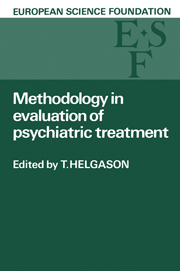 Methodology in Evaluation of Psychiatric Treatment
Methodology in Evaluation of Psychiatric Treatment from IV - OTHER QUANTITATIVE METHODS OFEVALUATION OF TREATMENT
Introduction
Different biological approaches (genetic, biochemical, neuroendocrine, neurophysiological) are used for studying psychiatric disorders. Some studies have attempted to find biological predictors ofthe response to various treatments. Although this field is a relatively new one, the results being sometimes controversial, its impact on research and treatment is of great importance.
We shall attempt to review some of the promising areas of research into biochemical predictors in relation to treatment response mainly in affective illnesses, as little data is available for schizophrenia and other psychiatric disorders. Table 1 shows the main biochemical predictors of treatment response in affective disorders.
Response to tricyclic antidepressants
Methoxy-4-hydroxyphenyl glycol (MHPG) studies
MHPG, the major metabolite of central norepinephrine (NE), may provide a useful index of brain NE turnover when measured in 24-hour urine tests (Schildkraut et aI1978). Maas et al (1972) reported low (< 900mg MHPG/g creatinine) pre-treatment urinary MHPG concentration in depressed patients who responded to imipramine and desipramine and high (>1350mg MHPGIg creatinine) MHPGconcentration in imipramine and desipramine non-responders. In the same study, Maas et at also reported that other NE metabolites (vanillyl mandelic acid, normetanephrine and metanephrine) did not predict response to imipramine in the same patients.
Schildkraut (1973) found high urinary MHPG excretion in amitriptyline- responders and low pre-treatment urinary MHPG levels in amitriptyline non-responders.
Beckman & Goodwin (1975) reported the mean urinary excretion of MHPG to be high (2,170 IJg/24h) in the imipramine responders. A low urinary MHPG excretion rate was also found by Hollister et al (1980) in patients responding to nortriptyline.
In a recent study, Cobbin et al (1979) applied these observations to clinical practice. The authors found a significantly better drug response in the group of patients when treatment was chosen by biochemical criteria (pre-treatment MHPG urinary level) than in those where treatment was decided on the basis of clinical criteria.
An interesting finding is the prediction of good response to imipramine and desipramine by the D-amphetamine test. When given D-amphetamine orally for two days, some depressed patients show a transitory enhancement of mood. In the study of Fawcett & Siomopoulos (1971), D-amphetamine responders showed a good response to imipramine and desimipramine and had low pre-treatment urinary MHPG levels.
To save this book to your Kindle, first ensure [email protected] is added to your Approved Personal Document E-mail List under your Personal Document Settings on the Manage Your Content and Devices page of your Amazon account. Then enter the ‘name’ part of your Kindle email address below. Find out more about saving to your Kindle.
Note you can select to save to either the @free.kindle.com or @kindle.com variations. ‘@free.kindle.com’ emails are free but can only be saved to your device when it is connected to wi-fi. ‘@kindle.com’ emails can be delivered even when you are not connected to wi-fi, but note that service fees apply.
Find out more about the Kindle Personal Document Service.
To save content items to your account, please confirm that you agree to abide by our usage policies. If this is the first time you use this feature, you will be asked to authorise Cambridge Core to connect with your account. Find out more about saving content to Dropbox.
To save content items to your account, please confirm that you agree to abide by our usage policies. If this is the first time you use this feature, you will be asked to authorise Cambridge Core to connect with your account. Find out more about saving content to Google Drive.